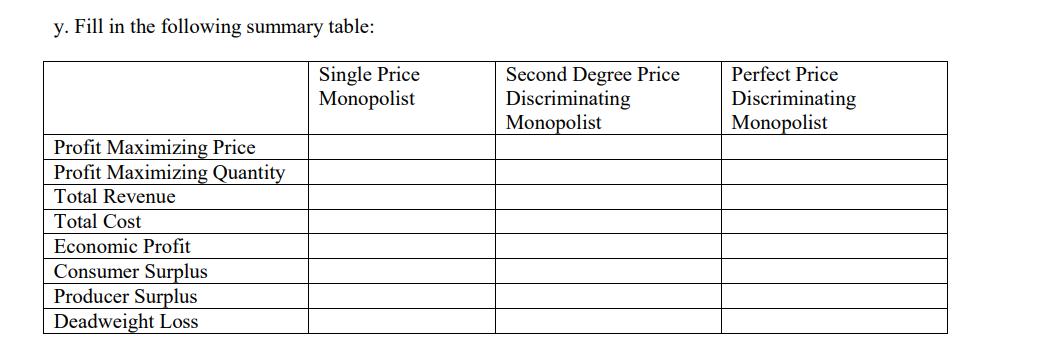Answered step by step
Verified Expert Solution
Question
1 Approved Answer
Consider a monopoly that faces a market demand curve given as P = 100 - Q. The marginal cost of production for this monopolist

![]()
![]()
![]()
![]()
![]()
![]()

![]()
![]()
![]()

![]()
![]()
![]()
![]()
![]()
![]()
![]()
![]()
![]()
![]()
![]()
![]()

Consider a monopoly that faces a market demand curve given as P = 100 - Q. The marginal cost of production for this monopolist is MC = 10 and the monopolist has fixed costs equal to zero. The monopolist has asked you to compare what happens if the monopolist is a single-price monopolist, a second degree price discriminating monopolist, and a perfect price discriminating monopolist. At the end of this question you will be asked to fill out a table to summarize your findings. i) Single-price monopolist: Suppose the monopolist charges a single-price for its product. Given this assumption, find the answers to the following questions: a. What is the profit maximizing quantity and price for this single-price monopolist? b. What is total revenue (TR) equal to for this monopolist? c. What is total cost (TC) equal to for this monopolist? d. What are the economic profits for this single-price monopolist? e. What is the value of consumer surplus (CSm) for this monopolist? f. What is the value of producer surplus (PSm) for this monopolist? g. What is the deadweight loss (DWLm) equal to for this monopolist? h. Provide a graph of this single-price monopolist indicating CSm, PSm, DWLm, the profit maximizing quantity, and the profit maximizing price. i. How many units of the good will the monopolist sell at $80 per unit? j. How many units of the good will the monopolist sell at $55 per unit? k. What is total revenue (TR) for this monopolist when he practices second degree price discrimination as described? 1. What is total cost (TC) for this monopolist when he practices second degree price discrimination as described? m. What are the economic profits for this second degree price discriminating monopolist? n. What is the value of consumer surplus (CS2) for this monopolist? o. What is the value of producer surplus (PS2) for this monopolist? p. What is the deadweight loss (DWL2) equal to for this monopolist? q. Provide a graph of this second degree price discriminating monopolist indicating CS2, PS2, DWL2, as well as the prices and quantities that the monopolist selects. r. How many units will the perfect price discriminating monopolist produce? s. Describe the price(s) the perfect price discriminating monopolist will charge. t. What is the value of consumer surplus (CSppd) for this perfect price discriminating monopolist? u. What is the value of producer surplus (PSppd) for this perfect price discriminating monopolist? v. What is the value of deadweight loss (DWLppd) for this perfect price discriminating monopolist? w. What do economic profits equal for this perfect price discriminating monopolist? Show your work to get this answer. x. Draw a diagram graph of this perfect price discriminating monopolist indicating PSppd, DWLppd, as quantity that the monopolist selects. y. Fill in the following summary table: Profit Maximizing Price Profit Maximizing Quantity Total Revenue Total Cost Economic Profit Consumer Surplus Producer Surplus Deadweight Loss Single Price Monopolist Second Degree Price Discriminating Monopolist Perfect Price Discriminating Monopolist
Step by Step Solution
There are 3 Steps involved in it
Step: 1
The detailed ...
Get Instant Access to Expert-Tailored Solutions
See step-by-step solutions with expert insights and AI powered tools for academic success
Step: 2

Step: 3

Ace Your Homework with AI
Get the answers you need in no time with our AI-driven, step-by-step assistance
Get Started


